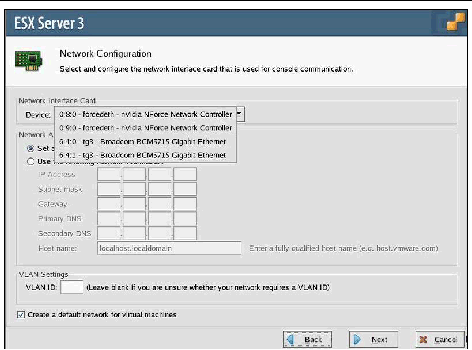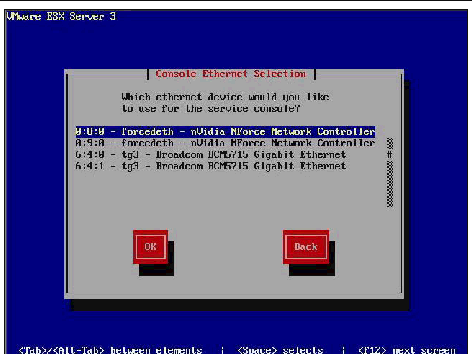| C H A P T E R 5 |
|
Installing VMware |
This chapter explains the procedure to install VMware ESX Server 3.0.2 (and later) on the Sun Fire X2200 M2 servers and includes the following sections:
You can install the VMware ESX Server software from a local CD/DVD drive, a remote CD/DVD drive, or the network. The most common methods to install VMware on your server are:
1. Installation from downloaded image (from the VMware website) burned onto CD/DVD media.
2. Automatic kickstart installation from VMware software (installation tree) stored on a Preboot Execution Environment (PXE) network server.
You can find detailed information and procedures concerning VMware virtualization software at:
http://www.vmware.com/support/pubs
Before you begin installing VMware ESX Server software on a Sun Fire X2200 M2 server, consult the following documents for VMware ESX Server install, at:
http://www.vmware.com/support/pubs/vi_pubs.html
Consult the following table to determine which sections in this document are relevant to the installation tasks that you want to perform.
|
Section 5.1.1, VMware Installation and Administration Documentation. |
|
|
Begin installing the VMware ESX software using a local or network-attached CD or virtual CD drive. |
|
|
See: http:// |
|
The Virtual Infrastructure 3 service console and management interface is dependent on a network interface. The service console does not automatically use the first interface with a live connection. If you do not physically connect all network interfaces, a live interface must be associated with the service console for host management.
See your Sun Fire X2200 M2 Server Service Manual for detailed information concerning network interface cabling and the BIOS considerations of these interfaces.
By default, vmnic0 is assigned for service console communications.
The following procedure applies to installing VMware ESX Server from a local CD-ROM, or a virtual CD-ROM redirected from Java Console.
1. Read the required documents for VMware ESX Server.
2. If no internal CD/DVD drive is available, use the network-attached virtual CD/DVD drive (or a USB CD-ROM).
|
1. From a network-connected system with CD-burning capabilities, download the ISO image from:
| Note - If Java Remote Console is used to redirect a CD drive or image, you can select "Host Device" as the device type. |
3. Install the ESX Server software on the Sun Fire X2200 M2 system.
4. Update the ESX Server software if necessary.
Download available updates from:
http://www.vmware.com/support/
The process is detailed in the following sections.
Installing VMware ESX Server 3.0.2 and later on your Sun Fire X2200 M2 server, requires:
1. USB keyboard, mouse connected to rear USB ports of Sun Fire server, or access through a remote console.
2. Monitor connected to Sun Fire server (not required if you are using remote KVMS)
3. If there is no built-in CD-ROM, choose either one of the following:
5. The Installation and Upgrade Guide for VMware Infrastructure
|
1. Turn on the Sun Fire system.
2. Insert the media into CD-ROM drive. The server boots from the CD and display a boot prompt.
3. Choose the interface that you would like to work with:
4. From your network-connected system go to:
http://www.vmware.com/support/pubs/vi_pubs.html
5. Locate the Installation and Upgrade Guide for VMware Infrastructure.
Use the document to guide you through the installation process.
6. Identify the Sun Fire-specific network interface.
In the service console window on the Sun Fire system, identify the available network configuration alternatives (see FIGURE 5-1and FIGURE 5-2).
FIGURE 5-1 ESX Server 3 Network Configuration Graphical Mode Dialog Box

FIGURE 5-2 ESX Server 3 Network Configuration Text Mode Dialog Box

During ESX Server install network configuration, the interfaces are shown as these adapters if no extra or optional network controllers are installed in the Sun Fire X2200 M2 server:
7. Complete the VMware installation.
This is detailed in the Installation and Upgrade Guide for VMware Infrastructure available at http://www.vmware.com/support/pubs/vi_pubs.html.
When VMware ESX Server images are available for updates you can download from:
http://www.vmware.com/support/
Copyright © 2008, Sun Microsystems, Inc. All Rights Reserved.